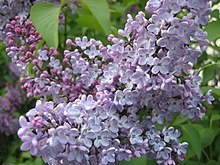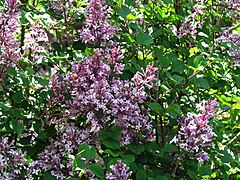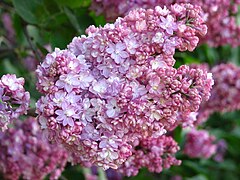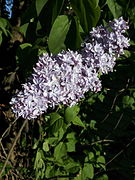
Adenophora is a genus of flowering plants in the family Campanulaceae, the bellflowers. Plants of this genus are known commonly as ladybells. Most are native to eastern Asia, with a few in Europe. Many are endemic to either China or Siberia.

Syringa vulgaris, the lilac or common lilac, is a species of flowering plant in the olive family Oleaceae, native to the Balkan Peninsula, where it grows on rocky hills. Grown in spring for its scented flowers, this large shrub or small tree is widely cultivated and has been naturalized in parts of Europe, Asia and North America. It is not regarded as an aggressive species. It is found in the wild in widely scattered sites, usually in the vicinity of past or present human habitations.

Syringa josikaea, the Hungarian lilac, or Lady Josika's lilac is a species of lilac in the olive family Oleaceae, native to central and eastern Europe, in the Carpathian Mountains in Romania and western Ukraine. A large shrub, it has a very restricted range, although fossils assigned to the species suggest a much wider prehistoric distribution in central Europe. Today it is threatened in the wild by habitat destruction, but is also commonly used in gardening.

Syringa reticulata, the Japanese tree lilac, is a species of flowering plant in the family Oleaceae native to eastern Asia, which is grown as an ornamental in Europe and North America.
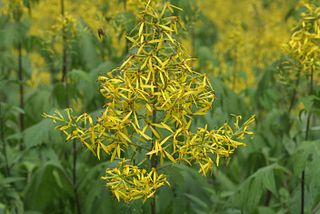
Sinacalia is a genus of Chinese plants in the groundsel tribe within the daisy family.

Spodiopogon is a genus of Asian plants in the grass family.

Neopallasia is a genus of Asian flowering plants in the chamomile tribe within the daisy family. Molecular data indicate that Neopallasia is closely related to Seriphidium and could be easily included with that genus.

Ptilagrostis is a genus of grasses in the family Poaceae. They are distributed in Asia and North America. They are known commonly as false needlegrasses.

Syringa villosa, the villous lilac, is a shrub native to Korea, the southern part of the Russian Far East (Primorye) and northern China. There are two subspecies currently recognized ; these are regarded as separate species in Flora of China. Combining the ranges for the two taxa yields a range within China of Hebei, Shanxi, Heilongjiang, Jilin, and Liaoning.

Campanula punctata, the spotted bellflower, is a species of flowering plant in the bellflower family Campanulaceae. This ornamental herbaceous perennial is native to Japan, Korea, China and Siberia, and is widely cultivated for its attractive bell-shaped flowers.

Syringa pubescens is a species of flowering plant in the lilac genus of the family Oleaceae, native to Korea and China.

Fragaria orientalis is a diploid species of wild strawberry native to E. Asia – Eastern Siberia. It is occasionally cultivated as a novelty edible.
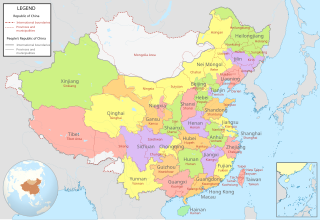
The history of the administrative divisions of China after 1949 refers to the administrative divisions under the People's Republic of China. In 1949, the communist forces initially held scattered fragments of China at the start of the Chinese Civil War. By late 1949, they controlled the majority of mainland China, forcing the Republic of China government to relocate to Taiwan.
Allium polyrhizum is a species of wild onion widespread across Zabaykalsky Krai, Kazakhstan, Mongolia, and China at elevations 1000–3700 m.

Allium ramosum, called fragrant-flowered garlic or Chinese chives is a northern Asian species of wild onion native to Kazakhstan, Mongolia, Siberia, the Russian Far East, and northern China. The species is also naturalized in a few places in eastern Europe. In its native range, it grows at elevations of 500–2100 m.
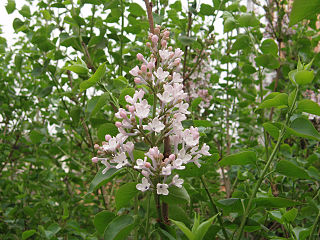
Syringa oblata is a species in the genus Syringa, in the family Oleaceae. It is also known as early blooming lilac or broadleaf lilac.

Syringa oblatasubsp.dilatata, also known as Korean early lilac, is a subspecies of the species Syringa oblata in the genus Syringa, in the family Oleaceae.

Aquilegia viridiflora, commonly known as the green columbine or green-flowered columbine, is a species of flowering plant in the buttercup family. Its native range is southern Siberia to northern China, and Japan. It is an herbaceous perennial, and grows 15 cm to 50 cm tall, with a maximum spread of approximately 30 cm. Although it is grown as an ornamental, it may be considered a weed.
